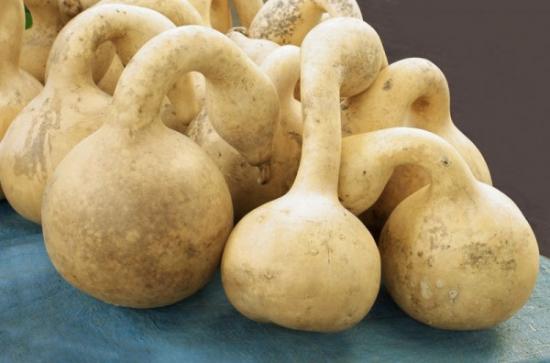Source - http://news.sciencemag.org/biology/2014/02/scientists-solve-mystery-world-traveling-plant

Bon voyage. Bottle gourds likely floated across the Atlantic to the Americas, where they were independently domesticated by humans.Brzostowska/Shutterstock
By land or by sea? That’s the question scientists have been pondering for decades when it comes to the bottle gourd, a plant with a hard-skinned fruit that’s used by cultures all over the world to make lightweight containers and other tools. Archaeologists know that people were using domesticated bottle gourds in the Americas as early as 10,000 years ago. But how did the plant make the jump from its original home in Africa to the New World with an ocean in the way? A new study overturns previous evidence pointing to a human-assisted land migration and concludes that the bottle gourd floated across the Atlantic Ocean to the Americas on its own.
Humans rarely eat the bottle gourd (Lagenaria siceraria), but rather dry out its fruit and fashion it into containers, tools like fishing floats or pipes, or even musical instruments. The plant comes in two subspecies linked to their geography: one from Africa, where the plant first evolved, and one from Asia. Researchers have long wondered whether the New World bottle gourds are more closely related to the African or Asian subspecies. If they could build a bottle gourd family tree, they thought, they might be able to figure out how the plant reached the Americas in the first place. Did it float over on ocean currents from Africa, the prevailing assumption until about 10 years ago, or did humans carry the plant with them when they walked across the Bering land bridge from Asia?
“It was a real puzzle,” says Bruce Smith, an archaeologist at the Smithsonian Institution’s National Museum of Natural History in Washington, D.C.
Then, in 2005, a study was published that seemed to solve the mystery once and for all. In a paper published in the Proceedings of the National Academy of Sciences, researchers analyzed the genetics of bottle gourds for the first time and found that pre-Columbian bottle gourds in the Americas appeared to be more closely related to the Asian subspecies than the African one. They concluded that the ancestors of New World bottle gourds must have been carried by people as they made their way across Asia, over the Bering land bridge, and down into the Americas.
But many scientists—including several of the study’s authors—had “lingering questions” about that hypothesis, says Andrew Clarke, a plant biologist at the University of Warwick in Coventry, U.K. and an author of the 2005 study. Most glaringly, how could the bottle gourd, a tropical plant, make it through years of traveling across the Arctic? And if humans carried it with them across the Bering land bridge, why is there no archaeological evidence of bottle gourds in Siberia, Alaska, or the Pacific Northwest?
Logan Kistler, an anthropologist at Pennsylvania State University, University Park, thought the question of bottle gourd dispersal was due for another look. Technology for studying ancient DNA has “really come a long way” since the 2005 study was done, he says. “We thought, since we had these updated technologies, it could be worth revisiting” that paper’s conclusions, he says.
Instead of the meager three genetic markers scientists were able to study in 2005, Kistler’s team analyzed 86,000 base pairs of ancient and modern bottle gourds’ chloroplast DNA, which can be used to build family trees for plants much in the way that maternally inherited mitochondrial DNA can be used to trace ancestry in humans. The expanded genetic analysis revealed that pre-Columbian bottle gourds in the Americas were more closely related to African gourds after all, the team reports online today in the Proceedings of the National Academy of Sciences. Using updated models of how objects drift on Atlantic currents, Kistler’s team concludes that the ancestors of New World bottle gourds probably floated to the West African coast by river, embarked on their Atlantic voyage at latitudes between 0° and 20° south or between 10° and 20° north, and landed on the coast of Brazil an average of 9 months later. So rather than bringing bottle gourds with them, the first human settlers of the Americas likely found a wild population of the useful plant waiting for them and eventually domesticated it, just as people on other continents did.
The new result is “a real relief,” says Smith, who was involved in both studies. “It just makes so much more sense” than the 2005 conclusion, he says. Clarke agrees: “Now, it’s really quite clear that [the bottle gourd] reached the New World under its own steam.”
Still, not all the questions about the bottle gourd have been answered. Scientists don’t know how it got to Asia, for example, and the scarcity of wild bottle gourds the world over begs the question of why uncultivated varieties of the plant disappeared. Kistler suggests that wild populations may have declined after megafaunal mammals like the mastodon went extinct and could no longer help disperse bottle gourd seeds in their dung. But for now, these pieces of the bottle gourd’s past remain mysterious.